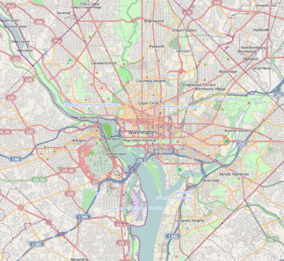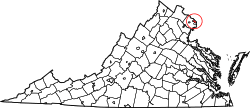Lyon Village, Arlington, Virginia
Lyon Village is a neighborhood, or “urban village” located in Arlington County, Virginia, along Lee Highway (U.S. Route 29). It is approximately one mile west of Rosslyn and less than a mile north of Clarendon, of which it is sometimes considered a sub-neighborhood.
A shopping center located at the confluence of Lee Highway, Spout Run Parkway and Interstate 66 (I-66) and a community house both serve the neighborhood. Parts of the neighborhood are near the Clarendon and Court House stations of Metrorail's Orange Line.
History
|
Lyon Village Historic District | |
|
| |
   | |
| Location | Roughly bounded by Lee Highway, N. Veitch St., N. Franklin Rd., N. Highland St., N. Fillmore St., and N. Kirkwood Rd., Arlington, Virginia |
|---|---|
| Coordinates | 38°53′29″N 77°5′42″W / 38.89139°N 77.09500°WCoordinates: 38°53′29″N 77°5′42″W / 38.89139°N 77.09500°W |
| Area | 191 acres (77 ha) |
| Built | 1846 |
| Architectural style | Late Victorian, Late 19th And 20th Century Revivals |
| NRHP Reference # | 02000512[1] |
| VLR # | 000-7822 |
| Significant dates | |
| Added to NRHP | May 10, 2002 |
| Designated VLR | December 5, 2001[2] |
According to the Arlington County Department of Libraries, Robert Cruit, an immigrant from Devonshire, England, purchased land in the Clarendon area in 1825 for a farm.[3] In 1923, his heirs sold the land to developer Frank Lyon, who subdivided it into tracts for residential development, including the eponymous Lyon Village. Most of the single family homes in the neighborhood were constructed in the 1920s and 1930s.
According to the listing for the Lyon Village Historic District, it encompasses 1,073 contributing buildings and 1 contributing structure. It was listed on the National Register of Historic Places in 2002. The description includes:
Lyon Village is a cohesive residential neighborhood in northern Arlington County, Virginia, located immediately north of the Clarendon Commercial District and roughly nestled between Wilson Boulevard to the south and Lee Highway to the north. These major thoroughfares both provide access to commercial and employment centers in the surrounding county and nearby Washington, D.C. The neighborhood extends east to North Veitch Street and westward to North Kirkwood Road. This eastern border provides direct access to the county courthouse and governmental center at Courthouse Square. The first portion of the neighborhood to be platted as Lyon Village was landscaped with tree-lined streets, traffic circles, and an intricate system of curvilinear roads that complemented the less-than-one-acre housing lots. This section of Lyon Village was platted in 1923 by Frank Lyon, who purchased the property from Robert Cruit's heirs. Aurora Heights and portions of Clarendon now fall within the current boundaries of Lyon Village and contain residential buildings constructed prior to Lyon's purchase of the Cruit property. Further, Lyon Village was further enlarged by the platting of adjacent blocks with a more grid-like street pattern from the 1930s to the 1950s. Consequently, the Lyon Village Historic District occupies approximately 191 acres, forty-three acres more than the original 148 acres platted by Frank Lyon in 1923.[4][5][6]
Lyon Village is defined by a variety of 20th-century architectural styles and building types ranging from early-20th-century high style to vernacular interpretations of the elaborate styles traditionally erected decades earlier. Primarily, the domestic buildings in Lyon Village range from the 1880s to infill housing of the late 1990s. Building forms and styles extend from the imposing brick Colonial Revival-style dwelling to the smaller bungalow. Architectural styles presented in Lyon Village were often diluted, illustrating modest examples of Queen Anne, Colonial Revival, Craftsman, Tudor Revival, Classical Revival and Spanish Mission Revival styles. The community is primarily made up of single-family dwellings, supported along the borders by multiple-family apartment buildings, a landscaped park and community building, churches, and commercial buildings (which are not included in the historic district). Many of the properties include freestanding or attached garages and sheds. The buildings, particularly the single-family dwellings, are buffered from the public streets by sidewalks and grassy medians.[4]
References
- ↑ National Park Service (2010-07-09). "National Register Information System". National Register of Historic Places. National Park Service.
- ↑ "Virginia Landmarks Register". Virginia Department of Historic Resources. Retrieved May 12, 2013.
- ↑ "Archived copy". Archived from the original on May 9, 2006. Retrieved August 16, 2006.
- 1 2 Carrie E. Albee and Laura V. Trieschmann (November 2002). "National Register of Historic Places Inventory/Nomination: Lyon Village Historic District" (PDF).
- ↑ "Lyon Village Historic District". virginia.gov.
- ↑ "North Arlington map" (PDF).
External links
| Wikimedia Commons has media related to Lyon Village Historic District. |
- Lyon Village apartments, local apartment buildings built by Frank Lyon
- Lyon Village Citizens Association, a voluntary neighborhood organization
- Urban Villages: Lyon Village - By the ART Commuter Page


